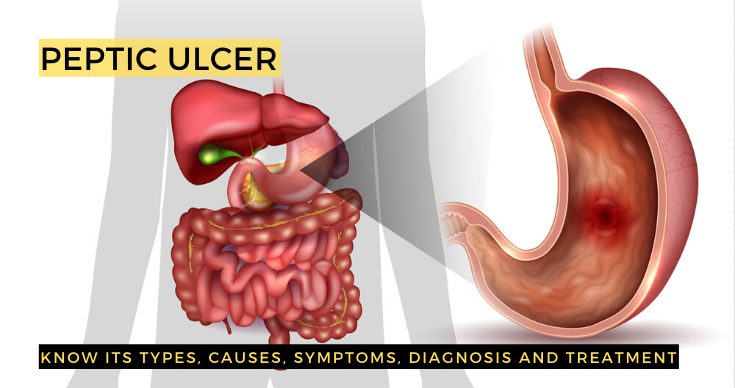Peptic Ulcer: Types, Causes, Symptoms, Diagnosis And Treatment
A peptic ulcer is an inflammation that develops in the lining of the stomach, the lower part of the esophagus and upper portion of the small intestine. It is a gastroenterological condition and thus, treated by gastroenterologists. They are open lesions and mainly of three types based on their location as follows:
-
Gastric (stomach) ulcer: Ulcers that occur in the stomach.
-
Esophageal ulcer: Ulcers that happen in the esophagus.
-
Duodenal ulcer: Ulcers that develop in the upper portion of the small intestine.
It is important to know why peptic ulcer happens in the first place. The primary reason behind the occurrence is when the stomach acids responsible for digestion damages the lining of the stomach and sometimes even travel to the esophagus causing esophageal ulcer. The bacteria Helicobacter Pylori (H. Pylori) also contributes by inflaming the lining of the stomach. Surely, other causes are present as well which you’ll find below:
-
Smoking
-
Overuse of over-the-counter drugs
-
Infection from H. Pylori bacteria due to consuming contaminated food, water, using uncleaned utensils etc.
-
Overconsumption of alcohol.
Let’s now focus on the symptoms of a peptic ulcer.
-
Indigestion
-
Heartburn or acid reflux
-
Vomiting or regurgitation
-
Bloating and burping
-
Belching
-
Black stools
-
Nausea
-
Fatigue
-
Unintentional or unexpected weight loss
-
Loss of appetite
-
Pain in the abdomen and chest
-
Facing difficulties in breathing.
A diagnosis is always needed to confirm any medical condition. Apart from the mandatory physical examination in which the doctor check for bloating and pain, certain other crucial diagnostic tests can also be prescribed by the medical professional for an accurate diagnosis. They include:
-
Blood test – to determine the presence of H. Pylori bacteria.
-
H. Pylori stool antigen test – to look for H. Pylori infection.
-
Urea breath test or H. Pylori breath test – to conduct this test, the patient is asked to consume something with radioactive carbon (either in pill or liquid form) and then the breath samples are taken for lab testing procedure which accurately confirms the existence of the bacteria.
-
Gastroscopy – an endoscope is anaesthetically inserted inside the patient’s mouth to view the stomach, duodenum and esophagus for ulcers.
-
Endoscopy biopsy – the same as gastroscopy and in case of an ulcer detection, the samples are taken for clinical purposes.
The treatment options are as follows:
1. Antibiotics (to kill the bacteria, H. Pylori)
2. Antacids (to neutralize the stomach acid)
3. Cytoprotective drugs (to protect the mucous lining of the stomach)
4. Surgical treatment (if the above method fails and the ulcer recurs)
Get accurate diagnosis and treatment for peptic ulcer only from ILS Hospitals, one of the best hospitals in Kolkata and Agartala.
4 Common Gastrointestinal Diseases That You Should Be Aware Of
We all come across articles with catchy titles like ‘best food for weight loss’, ‘worst food during pregnancy’, and so on, isn’t it! Indeed the food we eat determines many health factors for us. However, sometimes the passage of food, the digestive tract, itself gets inflicted with many diseases. In fact, the number of gastrointestinal conditions is on a rise since the past few decades. Let’s take a look at some of the most common ones of them.
Gastrointestinal conditions are the diseases that originate in any or more of the organs of the GI tract and its accessory organs. It includes the esophagus, stomach, gallbladder, liver, pancreas small and large intestine, colon and rectum. A good Gastroenterologist can offer extensive treatment of the same.
Some of the most common GI conditions are as follows.
1. GERD (Gastroesophageal reflux disease)
Acidity, reflux and heartburn are some most commonly experienced symptoms related to digestion. GERD is the severe form of such acid reflux. It is characteristic by regular acid reflux, often with a sour or bitter taste in the mouth. GERD might be a result of underlying hiatal hernia (for which hernia treatment must be sought immediately) and moreover, untreated GERD can severely harm the esophagus, so it is advised to address it on time.
2. Gallstones
Gallstones is yet another most common GI condition. Gallstones are solidified, crystalline substance that occurs inside the gallbladder. Its size may vary from small granular to big golf ball sized. It causes tremendous pain and can be eased with medicines. However, it is crucial to note that gallstones are mostly impossible to cure with medicine, and it can only be treated permanently with gallstone operation.
3. Gastroenteritis
This is a pathogen infection of the GI tract, which can include, bacteria, virus and parasites. It brings multiple symptoms at once, such as vomiting, diarrhea, headache and also fever. Usually, it is known as common stomach flu. The mild flu can be managed easily with adequate rest, plenty of water and minerals and mild over-the-counter drugs. But it might need some medical treatment, if the symptoms persist for long, or if it triggers again and again. However, these are easily spread and measures should be taken to avoid the possibility.
4. Peptic Ulcers
Unhealthy diet, lifestyle and excessive use of certain medicines can deteriorate the inner membrane of the stomach and expose it to the digestive acids. This results in ulcers and causes several digestive complications, if left unresolved. It often cannot resolve on its own, as the ulcers stay exposed to the enzymes persistently. Thus, its timely treatment is quite important and so is making certain changes in the diet and lifestyle.
There are several other GI conditions as well which need to be treated effectively. At ILS Hospitals, we offer extensive diagnosis treatment for a wide range of GI conditions.












